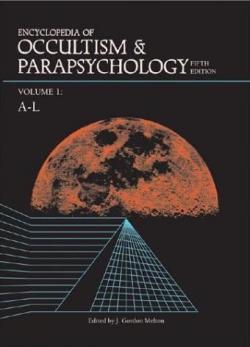
Laure Junot d'Abrantès
EAN : 9780810301856
Gale Research Company (01/12/1978)
/5
1 notes
Gale Research Company (01/12/1978)
Résumé :
This fifth edition of the Encyclopedia of Occultism & Parapsychology (EOP) continues the tradition established by its predecessors in providing the most comprehensive coverage of the fields of occultism and parapsychology. The first edition, published in 1978, brought together the texts of two of the standard reference works in the field, Lewis Spence’s Encyclopedia of Occultism (1920) and Nandor Fodor’s Encyclopedia of Psychic Science (1934). Later, editor Leslie S... >Voir plus
étiquettes
Ajouter des étiquettes
Que lire après Encyclopedia of occultism & parapsychologyVoir plus
Citations et extraits (3)
Ajouter une citation
Fascinum
An artificial male phallus reportedly used in witchcraft ceremonies. Evidence of the artificiality of claimed copulation with the devil is the frequent reference to the coldness of the phallus. Centuries before the great witchcraft manias of Europe, the fascinum was used in ancient religious rituals, such as those connected with worship of the god Priapus; such phalli were also known in ancient Egypt. Probably the earliest known is that of the fertility god Min at Koptos, around 5500 B.C.E.
An artificial male phallus reportedly used in witchcraft ceremonies. Evidence of the artificiality of claimed copulation with the devil is the frequent reference to the coldness of the phallus. Centuries before the great witchcraft manias of Europe, the fascinum was used in ancient religious rituals, such as those connected with worship of the god Priapus; such phalli were also known in ancient Egypt. Probably the earliest known is that of the fertility god Min at Koptos, around 5500 B.C.E.
The Evolution of Occultism
The present-day view of the occult is highly influenced by the history of the paranormal in the West during the nineteenth and twentieth centuries. Through the seventeenth century, most people believed in the active operation of occult (then termed “supernatural”) entities and forces. This belief brought comfort to some; but, for others, it became a source of fear, leading to suffering, and even death, for many. It allowed some people to rule by their reported ability to manipulate supernatural powers, and made it possible for the Inquisition to persecute thousands as witches and Satanists. It also enabled unscrupulous religious leaders to deceive people with sham relics and miracles.
The present-day view of the occult is highly influenced by the history of the paranormal in the West during the nineteenth and twentieth centuries. Through the seventeenth century, most people believed in the active operation of occult (then termed “supernatural”) entities and forces. This belief brought comfort to some; but, for others, it became a source of fear, leading to suffering, and even death, for many. It allowed some people to rule by their reported ability to manipulate supernatural powers, and made it possible for the Inquisition to persecute thousands as witches and Satanists. It also enabled unscrupulous religious leaders to deceive people with sham relics and miracles.
Bagoe
A pythoness (priestess of Delphi in ancient Greece) who is believed to have been the Erithryean sibyl. She is said to have been the first woman to have practiced the diviner’s art. She practiced in Tuscany and judged all events by the sound of thunder. Some identify Bagoe with Bigois, another Tuscan sorcerer.
A pythoness (priestess of Delphi in ancient Greece) who is believed to have been the Erithryean sibyl. She is said to have been the first woman to have practiced the diviner’s art. She practiced in Tuscany and judged all events by the sound of thunder. Some identify Bagoe with Bigois, another Tuscan sorcerer.
autres livres classés : parapsychologieVoir plus
Les Dernières Actualités
Voir plus
Autres livres de Laure Junot d'Abrantès (22)
Voir plus
Quiz
Voir plus
Freud et les autres...
Combien y a-t-il de leçons sur la psychanalyse selon Freud ?
3
4
5
6
10 questions
433 lecteurs ont répondu
Thèmes :
psychologie
, psychanalyse
, sciences humainesCréer un quiz sur ce livre433 lecteurs ont répondu
































